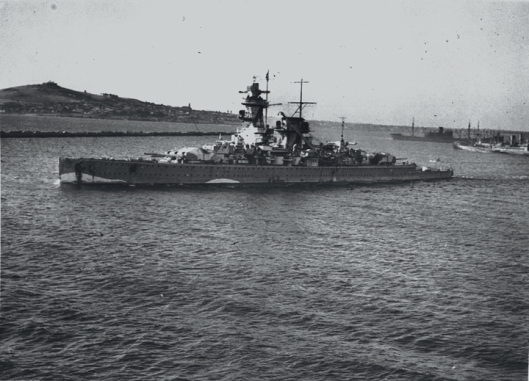
Admiral Graf Spee in Montevideo following the battle.
The Admiral Graf Spee (usually known as the Graf Spee) and her sister Admiral Scheer were beamier versions of the prototype Deutschland and had less range. Popularly known as ‘pocket battleships’, they were actually known to the German navy as Panzerschiffe, or armoured ships, and were in fact only very heavily gunned heavy cruisers. They were an answer to the restrictions of the Versailles Treaty which followed Germany’s defeat in 1918. Germany was not allowed to build warships displacing more than 10000 tons or armed with guns larger than 280 mm (11 in), with the avowed intention of limiting her to coast defence ships.
But the German constructors, by using lightweight construction and welding, as well as economical diesel engines, but above all by concealing the true tonnage, produced a warship with heavy gun power and impressive range. This caused a sensation among the world’s navies. Here, apparently, was the ideal commerce-raider, faster than anything more powerful (apart from a handful of battlecruisers) and more powerful than anything faster.
However, no other navy copied the design and the Germans built only three of them. The diesels were not quite as successful as hoped, and the new generation of fast battle- ships with speeds of 28-30 knots threatened the rationale of the design. Nor were their fighting qualities all that was required. The concentration of the heavy armament in two turrets was a weak point, while the protection was little better than that of the 8-in (200-mm) gunned ‘treaty cruisers’ that were their most likely opponents. In short, the pocket battle- ship was a needlessly large and expensive commerce-raider, for whom the most important rule was to avoid action with any war- ship which could fight back.
The Graf Spee was the last of the type to be built, being ordered under the 1932 Programme and launched in 1934. She differed from the Scheer in having a thinner but deeper armour belt, and in carrying slightly more fuel. She was at sea when war broke out in September 1939, having already proceeded to her war station in the Atlantic. During a moderately successful cruise in the South Atlantic she sank nine ships (50,089 tons), without a single life being lost. However, early on the morning of December 13, 1939, she sighted three British cruisers off Montevideo, the 8-in (200-mm) gunned Exeter and the 6-in (152-mm) gunned Ajax and Achilles.
Captain Langsdorff decided to engage. He had the advantage of a primitive radar set, but all British cruisers had practised antiradar tactics for years past and, in accordance with well-established doctrine, the Exeter and her two consorts split up to divide the German fire. During the ‘Battle of the River Plate’ which followed, the Exeter was badly damaged, while the Ajax was not in much better state, but the Graf Spee fired away most of her ammunition and suffered sufficient damage to make her put into Montevideo for repairs. Once there, her captain was bluffed into thinking that the British had gathered reinforcements, and four days later she steamed out to be scuttled by charges detonated in the main magazines and the engine room.